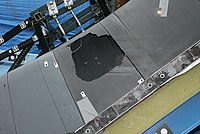
Photo from wikipedia
It is still a challenge to machine high-strength carbon fiber–reinforced polymer with high quality due to its poor machinability. Fiber direction is the critical factor. This article aims to investigate… Click to show full abstract
It is still a challenge to machine high-strength carbon fiber–reinforced polymer with high quality due to its poor machinability. Fiber direction is the critical factor. This article aims to investigate the effects of fiber cutting angle in milling of high-strength unidirectional carbon fiber–reinforced polymer laminates with regard to milling forces, machined surface morphology and surface roughness. The edge trimming and slot milling tests were conducted. The largest radial and tangential forces were observed on 135° fiber cutting angle followed by 90° while the smallest milling forces were observed on 45° fiber cutting angle. Totally, four basic material fracture mechanisms, that is, fiber–matrix debonding, bending-induced fiber fracture, shear-induced fiber fracture and compression-induced fiber fracture, were observed by the analysis of fracture morphology for a single fiber. The four basic material fracture mechanisms dominate the material fracture behavior during the cutting of carbon fiber–reinforced polymer. Besides, it is indicated that surface roughness of the machined surfaces is highly related to the type of the surface defects. Surface cavities caused by fiber–matrix debonding and bending-induced fiber fractures on 45° fiber cutting angle were observed to be the main factors leading to the decline of surface finish in milling of carbon fiber–reinforced polymer laminates.
Journal Title: Proceedings of the Institution of Mechanical Engineers, Part B: Journal of Engineering Manufacture
Year Published: 2018
Link to full text (if available)
Share on Social Media: Sign Up to like & get
recommendations!